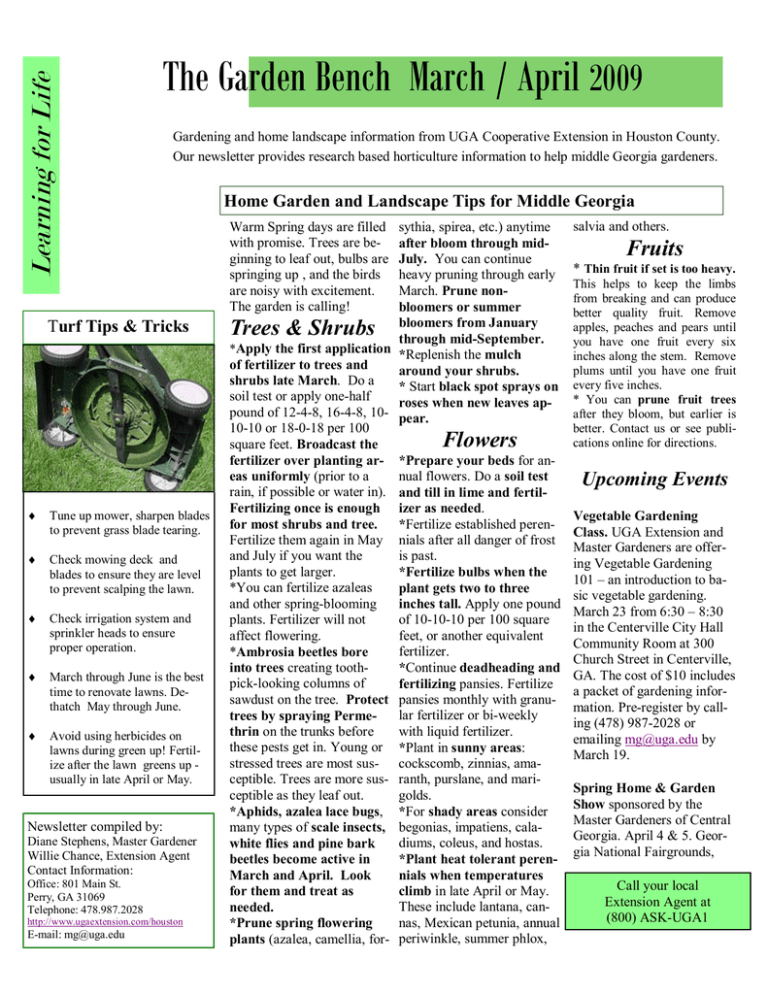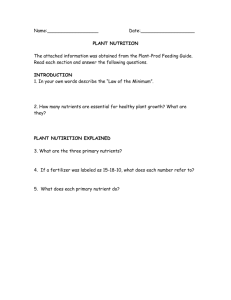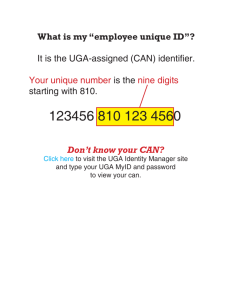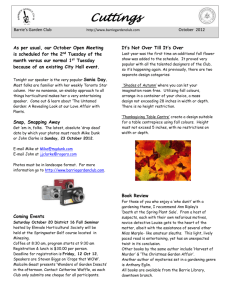The Garden Bench March / April 2009 Fruits
advertisement

Learning for Life The Garden Bench March / April 2009 Gardening and home landscape information from UGA Cooperative Extension in Houston County. Our newsletter provides research based horticulture information to help middle Georgia gardeners. Turf Tips & Tricks Home Garden and Landscape Tips for Middle Georgia Warm Spring days are filled with promise. Trees are beginning to leaf out, bulbs are springing up , and the birds are noisy with excitement. The garden is calling! sythia, spirea, etc.) anytime after bloom through midJuly. You can continue heavy pruning through early March. Prune nonbloomers or summer bloomers from January through mid-September. *Apply the first application *Replenish the mulch of fertilizer to trees and around your shrubs. shrubs late March. Do a * Start black spot sprays on soil test or apply one-half roses when new leaves appound of 12-4-8, 16-4-8, 10- pear. 10-10 or 18-0-18 per 100 square feet. Broadcast the fertilizer over planting ar- *Prepare your beds for annual flowers. Do a soil test eas uniformly (prior to a rain, if possible or water in). and till in lime and fertilFertilizing once is enough izer as needed. for most shrubs and tree. *Fertilize established perenFertilize them again in May nials after all danger of frost and July if you want the is past. plants to get larger. *Fertilize bulbs when the *You can fertilize azaleas plant gets two to three and other spring-blooming inches tall. Apply one pound of 10-10-10 per 100 square plants. Fertilizer will not feet, or another equivalent affect flowering. fertilizer. *Ambrosia beetles bore *Continue deadheading and into trees creating toothpick-looking columns of fertilizing pansies. Fertilize sawdust on the tree. Protect pansies monthly with granular fertilizer or bi-weekly trees by spraying Permewith liquid fertilizer. thrin on the trunks before these pests get in. Young or *Plant in sunny areas: stressed trees are most sus- cockscomb, zinnias, amaceptible. Trees are more sus- ranth, purslane, and marigolds. ceptible as they leaf out. *Aphids, azalea lace bugs, *For shady areas consider many types of scale insects, begonias, impatiens, caladiums, coleus, and hostas. white flies and pine bark *Plant heat tolerant perenbeetles become active in nials when temperatures March and April. Look climb in late April or May. for them and treat as These include lantana, canneeded. nas, Mexican petunia, annual *Prune spring flowering plants (azalea, camellia, for- periwinkle, summer phlox, Trees & Shrubs Flowers ♦ Tune up mower, sharpen blades to prevent grass blade tearing. ♦ Check mowing deck and blades to ensure they are level to prevent scalping the lawn. ♦ Check irrigation system and sprinkler heads to ensure proper operation. ♦ March through June is the best time to renovate lawns. Dethatch May through June. ♦ Avoid using herbicides on lawns during green up! Fertilize after the lawn greens up usually in late April or May. Newsletter compiled by: Diane Stephens, Master Gardener Willie Chance, Extension Agent Contact Information: Office: 801 Main St. Perry, GA 31069 Telephone: 478.987.2028 http://www.ugaextension.com/houston E-mail: mg@uga.edu salvia and others. Fruits * Thin fruit if set is too heavy. This helps to keep the limbs from breaking and can produce better quality fruit. Remove apples, peaches and pears until you have one fruit every six inches along the stem. Remove plums until you have one fruit every five inches. * You can prune fruit trees after they bloom, but earlier is better. Contact us or see publications online for directions. Upcoming Events Vegetable Gardening Class. UGA Extension and Master Gardeners are offering Vegetable Gardening 101 – an introduction to basic vegetable gardening. March 23 from 6:30 – 8:30 in the Centerville City Hall Community Room at 300 Church Street in Centerville, GA. The cost of $10 includes a packet of gardening information. Pre-register by calling (478) 987-2028 or emailing mg@uga.edu by March 19. Spring Home & Garden Show sponsored by the Master Gardeners of Central Georgia. April 4 & 5. Georgia National Fairgrounds, Call your local Extension Agent at (800) ASK-UGA1 Home Vegetable Gardening Wayne McLaurin & Darby Granberry, Retired Ext. Horticulturists A well-tended garden can supply you and your family with a variety of nutritious vegetables to be eaten fresh or preserved. Garden site If possible, select a site that has at least 6 - 8 hours of sun and is located near the house and a water supply. The soil should be loamy, fertile & well drained. Make a Plan Plan your garden so that the available space can be used wisely. For small areas, select those crops that you like best and that will produce an adequate supply on a few plants. Plan to use the space continuously by planting another in-season crop soon after the last harvest is completed. Web Page Links Houston County Cooperative Extension Homepage http://www.ugaextension.com/houston Middle Georgia Master Gardeners Home Page http://www.mgcg.org/ Cooperative Extension Home Page http://www.caes.uga.edu/extension/ Gardening & Landscape Information UGA Urban Ag Web site: www.gaurbanag.org The University of Georgia and Ft. Valley State University, the U.S. Department of Agriculture and counties of the state cooperating. The Cooperative Extension Service offers educational programs, assistance and materials to all people without regard to race, color, national origin, age, sex or disability. AN EQUAL OPPORTUNITY / AFFIRMATIVE ACTION ORGANIZATION Plant tall-growing plants together on the north or west side of the garden so they will not shade lower-growing plants. Make a map and keep it current so that the vegetables can be rotated within the garden from year to year. Lime and Fertilizer Have a soil test run to determine lime and fertilizer needs. If the pH is low (acidic soil), apply the recommended amount of lime before preparing the soil so it can be mixed with the soil during soil preparation. A pH of 6.0 to 6.5 is recommended for all vegetables except Irish potatoes, which require a pH of 5.5 to 5.8. Vegetables are classified as light, medium and heavy feeders, based on their fertilizer needs. Planting the Garden Information on cultivars, planting dates and spacing is given in the planting chart. Several vegetables can be successively planted to lengthen the harvesting season. Cultivation Cultivate or hoe the garden as often as needed to control weeds and grasses. Do not cultivate or hoe too deeply or you will injure roots. Mulch A mulch of straw, leaves, ground landscape waste or pine straw will help conserve moisture and control weeds. Apply enough mulch to have two to four inches after settling. Do not pile mulch against the base of vegetables. Watering Water as needed to maintain a uniform moisture supply. In the absence of rain, one inch of water once a week will probably be adequate for heavier soils. Sandy soils might require 2 applications of 1/2 to 3/4 inch of water twice a week. Water early in the morning so foliage will dry off quickly. This helps prevent diseases. Control Insects, Diseases and Nematodes Serious losses can occur from insects, diseases and nematodes. If nematodes are present, control measures must be taken before the crop is planted. Plant vegetable varieties that are resistant to nematodes and major diseases! Watch for insects and diseases and begin control measures as soon as problems are spotted. Contact your County Extension Agent for help in identifying pests & controls. Harvesting Harvest at the proper stage of maturity to get the highest quality vegetables. If crops such as beans, okra, squash and cucumbers are left on the vine to mature, the plants will stop producing It is essential to pick vegetables regularly. Any surplus production should be canned or frozen as soon as possible after harvesting. Information on canning and freezing is available at your county Extension office or at www.fcs.uga.edu/ext/pubs/food.php?c ategory=Preserving We edited these materials from the publication Home Vegetable Gardening found online at: http://pubs.caes.uga.edu/caespubs/pubs/PDF/L171.pdf








